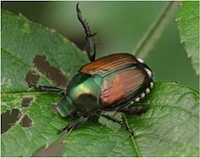Country Club Historic Neighborhood
Japanese Beetle Alert!
Japanese Beetles, once unknown in Denver, have arrived especially in areas close to irrigated golf courses like those of the Denver Country Club. Eradication requires killing them as young grubs when they spend winter in the soil where they feed on grass roots. The beetles then emerge in late June and throughout the summer and suck the nutrients from the leaves and, especially, light-colored flowers (roses are a big favorite).
But they can be controlled or at least reduced in number, NOT by squishing them as that releases a pheromone that will attract other beetles. Instead
- Prepare a cup of extra soapy water (the amount of dish soap you would typically use for a whole sink load) and then
- Drown them by either tipping the leaf so as to dislodge them into the soapy water or use a spoon (a wooden one works well) to knock them into the cup. The soap in the water reduces the surface tension, which makes the beetles drown easily.
- Then grind them up in your garbage disposal (but not in the trash or your compost pile, where they will attract their friends and family!).
A few other tips. Beetles are sluggish in the morning, making it easier to pick them off. If the beetle has embedded itself in a flower, it is best to drop the whole flower into the water since even if you kill that fellow, another one will pick up the scent and replace him (or her)! Sometimes the beetles try to escape by climbing to the top of the flower, but you can easily re-submerge them with your spoon – they don’t last long. And if you’re feeling especially thorough, pick off the beetle-killed, lace-like leaves, as that too will discourage future visitors!
The Denver Botanic Gardens has begun installing multiple pheromone traps. If our Country Club Neighborhood were to adopt them in sufficient number, and the Denver Country Club did so as well, it is possible that we might be able to control our fairly isolated Denver population of Japanese beetles. Other treatments exist, including treating lawn areas with spores of the bacterium Bacillus papillae or with the bacteria, Bacillus thuringiensis japonenesis (see this article) … but this would entail a widespread campaign and neighborhood adoption.
Submitted by Lorna G. Moore, 171 Franklin Street.
- Membership
- Membership in this website is private. Request membership access.

